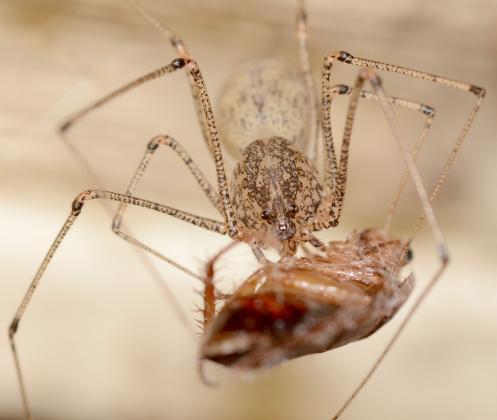This week’s featured creature is a scary-looking spider that isn’t really scary at all. At least, not to me anyway.
However, to insects and other arachnids, the spitting spider is quite scary – and deadly.
And it is definitely one of my favorite spiders.
One wouldn't think so by the appearance of its very thin, translucent legs, but in the bug world, spitting spiders are very efficient killers.
Those long, skinny legs help the spider spin silk around its prey.
And, spitters don’t make a web, they either hang out near a den waiting for insects or other spiders to get close enough, or they stalk along very slowly.
But they don’t grab prey by force. Once they creep up and are close enough to potential victims, they spray (or spit, if you will) two strands of spider silk in a zigzag pattern over the prey.
The silk strands are shot from the spider’s chelicerae and are sticky and venomous. The strike is lightning fast; 1.4 milliseconds, according to National Geographic.
The sprayed goop subdues the victim, then the spitting spider uses its long legs to wrap silk around the prey. It will then bite the victim and inject digestive agents which will liquify the insides of its prey.
Now, I said spitting spiders are among my favorites, but they are very adept at catching and consuming other spiders, including my favorites, jumping spiders.
Even though the spitting spider has venom, like nearly all spiders do, it poses no threat to humans. Its fangs are too small to penetrate human skin, but even if it could, it would be similar to a bee sting.
Description
Spitting spiders can grow to about 3/8 of an inch in body length (abdomen and cephalothorax). However, their long legs can make them appear much larger.
Spitting spiders in Oklahoma are brownish in color. However, their bodies are kind of translucent. The have dark speckles on the legs and bodies (see photos).
Habitat
According to the National Audubon Society, spitting spiders inhabit woods and fields under leaf litter and rocks, also in cellars and closets.
However, I often see them in my garage and under the soffit of my house. They tend to stay hidden during the day, then emerge at night to ambush or stalk prey.
Diet
Spitting spiders eat a variety of insects, and even other spiders, insects such as moths, cockroaches, crickets, true bugs, etc. are all on the menu.
Range
The spitting spider is most common in the southern half of the United States.
Editor’s Note: Randy Mitchell is a freelance writer and photographer. He has been an avid birdwatcher, nature enthusiast and photographer for more than 40 years. Reach him at rnw@usa.com.


